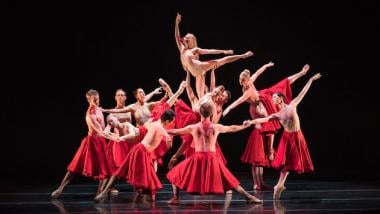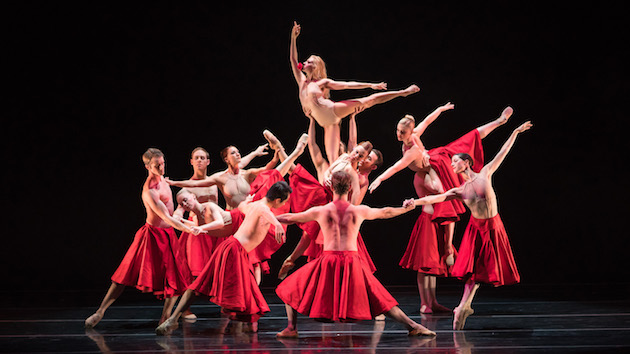
Smuin, to use the operative name for the Smuin Contemporary American Ballet, a 24-year-old troupe founded by the estimable Michael Smuin, launched its peripatetic season over the weekend at Lesher Center in Walnut Creek. Next Friday through Oct. 7 will be given over to shows at the Palace of Fine Arts, and if you’re near San Francisco, you really need to get there. In this, its first of three programs (the others are “The Christmas Ballet” and a spring repertory season April 20 to June 2), the company delivered a fine trio of pieces, showing itself to be not only beautifully tuned up but also in tune with the demand for ballets that aren’t the same-old, same-old. Even the nostalgic finale, Smuin’s Fly Me to the Moon (2004), was infused with a redemptive dash and zing.
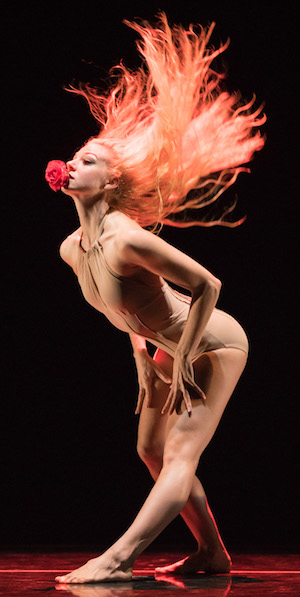
The standout on Saturday afternoon was Requiem for a Rose, by the terrific (and rare, as a female) choreographer Annabelle Lopez Ochoa. Her fluent and innovative creation stood up beautifully against Tatyana Van Waslum’s stunning design.
If you saw Cal Performances’ presentation of the Scottish Ballet’s A Streetcar Named Desire last March at Zellerbach, you know of Ochoa’s brilliance. Requiem, created in 2009 on the Pennsylvania Ballet and set to Schubert’s String Quartet in C (Adagio), flanked by weird bursts of electronica, expresses nigh-tactile sensations of love and loss.
Erica Felsch’s Rose solo triggered the work. As the curtain rose, she was a compelling, withering, wraithlike vision in a white leotard, bent forward, spotlit, her red-gold hair streaming to conceal her face. When she straightened, we saw that she held a red, red rose in her mouth. It was to stay there until the final curtain call.
A dozen dancers rushed onstage, supplanting her as the focus; the men as well as the women wore ruby-red knee-length skirts and moved with petaled perfection. Soon they clustered in a complex bouquet before giving way to brisk then languorous pairings plus an intriguing quartet. Ochoa’s work is impeccably musical and extra-demanding; there was one slight slip in a scrum of arabesques, but the dancers’ poise and the generous yet self-contained quality of their movement never faltered.
The roses (the women were on pointe) sometimes reflected the tenuousness of their existence (yes, it’s no bed of roses); their upper bodies quivered as if their stems were beginning to wilt. Ochoa was quoted in an interview as saying that roses as they die begin to stink — obviously losing their beauty. Although your reviewer thinks that’s debatable (it seems more as if it’s the water in the vase that begins to stink), Ochoa’s viewpoint certainly propels more compelling and contrasting interludes.
This nosegay of a ballet dances neatly between love versus romance, endurance versus transitory flirtation. Too, it meets the challenge of conveying the somberness of a requiem while sustaining the memory, the beauty, of what has engendered it. In all, Requiem for a Rose has the sweet smell of success.
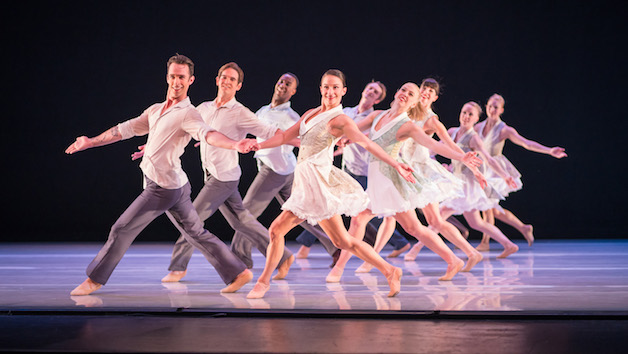
Serenade for Strings, created in 2013 and first danced by the Smuin troupe the following year, is a brave and showy piece. Choreographer Garrett Ammon was undaunted by the Tchaikovsky music, which George Balanchine used for one of his most iconic — not to mention most performed — ballets. Ammon, it turns out, chose wisely, investing the youthful-looking company with a buoyant take on the rites of young love. Unlike the Balanchine, there are no soulful mysteries, unless you count wondering how they did that strange neck lift, no mournful moves or moods. Led by prima-sans-portfolio Felsch, partnered by the lively Benjamin Warner, and followed by a wonderful array of duets and fluent ensemble work, this is a serenade while the sun shines — playful and frisky and perhaps owing a few moves (sly tilts of the body and swift shifts in direction) to the likes of Paul Taylor. If you’re going to borrow, borrow from the best. The women were in soft shoes, rather than on point, which added a dimension of naturalness to the proceedings. Under the longtime artistic direction of Celia Fushille, the company immediately makes audiences feel at home, projecting assurance, musicality, and innate warmth.
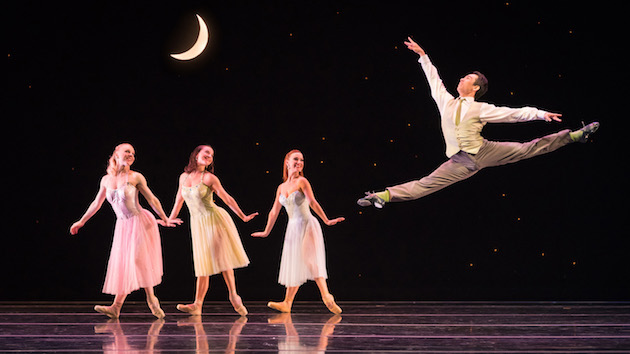
For a glam-bam finale, late founder Michael Smuin’s Fly Me to the Moon, the charming and durable Frank Sinatra tribute, is hard to beat. The dancers, singly, in couples, or in a final be-gowned, bejeweled, sequin-dazzled bow, managed to make every song (and they’re the ring-a-ding greatest) feel so young. Standouts among all the standouts included Ben Needham-Wood’s hat-juggling solo to “That’s Life,” Erin Yarbrough-Powell and Robert Kretz’s soulful pairing in “Moonlight Serenade,” and, in the title tune, Mengjun Chen, in the talented company of Terez Dean, Lauren Pschirrer, and Erin Yarbrough-Powell, soaring skyward.

